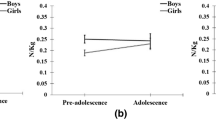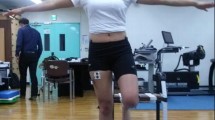Abstract
Purpose
Females athletes have a higher incidence of non-contact knee joint injuries compared to their male counterparts. This may be attributable to sex-specific differences in neuromuscular control, which arise during the pubertal growth spurt. The purpose of this longitudinal study was to assess the development of landing kinematics of adolescent male and female athletes during the adolescent growth-spurt.
Methods
One hundred and eighty-four adolescent athletes (55% male, 45% female; mean age = 13 ± 0.3 years) participated. Testing was undertaken at baseline and then repeated at 6, 12, 18 and 24 months. Participants performed three drop vertical jump (DVJ) trials from a 31 cm box. Frontal and sagittal plane knee joint angles were recorded. The average measurement of the three jumps was used for analysis at each time point. To assess maturation status, participants were categorised according to their age from peak height velocity at baseline. Pre-initial contact knee flexion (pre-IC), peak knee flexion and knee valgus displacement were the dependant variables. The categorical independent variables were sex (male versus female) and time.
Results
There was a significant sex*time interaction for pre-IC knee flexion, with males increasing knee flexion with time to a greater extent than females. There was no significant sex*time interaction for knee valgus displacement; although females displayed greater knee valgus displacement across all time points.
Conclusions
Adolescent male and female athletes display differing kinematic profiles across growth and development. This has clinical relevance for emphasising increased knee flexion, as well as decreasing abnormal frontal plane displacement in injury prevention programmes for adolescent females.
Level of evidence
II.

Similar content being viewed by others
References
Benjaminse A, Welling W, Otten B, Gokeler A (2015) Novel methods of instruction in ACL injury prevention programs, a systematic review. Phys Ther Sport 16:176–186
Brophy RH, Schmitz L, Wright RW, Dunn WR, Parker RD, Andrish JT, McCarty EC, Spindler KP (2012) Return to play and future ACL injury risk after ACL reconstruction in soccer athletes from the multicenter orthopaedic outcomes network (MOON) group. Am J Sports Med 40:2517–2522
DeVita P, Skelly WA (1992) Effect of landing stiffness on joint kinetics and energetics in the lower extremity. Med Sci Sports Exerc 24:108–115
Dingenen B, Malfait B, Nijs S, Peers KH, Vereecken S, Verschueren SM, Staes FF (2015) Can two-dimensional video analysis during single-leg drop vertical jumps help identify non-contact knee injury risk? A one-year prospective study. Clin Biomech 30:781–787
Dingenen B, Malfait B, Vanrenterghem J, Verschueren SM, Staes FF (2014) The reliability and validity of the measurement of lateral trunk motion in two-dimensional video analysis during unipodal functional screening tests in elite female athletes. Phys Ther Sport 15:117–123
DiStefano LJ, Martinez JC, Crowley E, Matteau E, Kerner MS, Boling MC, Nguyen AD, Trojian TH (2015) Maturation and sex differences in neuromuscular characteristics of youth athletes. J Strength Cond Res 29:2465–2473
Ford KR, Shapiro R, Myer GD, Van Den Bogert AJ, Hewett TE (2010) Longitudinal sex differences during landing in knee abduction in young athletes. Med Sci Sports Exerc 42:1923–1931
Gokeler A, Benjaminse A, Hewett TE, Paterno MV, Ford KR, Otten E, Myer GD (2013) Feedback techniques to target functional deficits following anterior cruciate ligament reconstruction: implications for motor control and reduction of second injury risk. Sports Med 43:1065–1074
Gokeler A, Benjaminse A, Welling W, Alferink M, Eppinga P, Otten B (2015) The effects of attentional focus on jump performance and knee joint kinematics in patients after ACL reconstruction. Phys Ther Sport 16:114–120
Hewett TE, Myer GD, Ford KR (2004) Decrease in neuromuscular control about the knee with maturation in female athletes. J Bone Joint Surg 86:1601–1608
Hewett TE, Myer GD, Ford KR, Heidt RS Jr, Colosimo AJ, McLean SG, Van Den Bogert AJ, Paterno MV, Succop P (2005) Biomechanical measures of neuromuscular control and valgus loading of the knee predict anterior cruciate ligament injury risk in female athletes: a prospective study. Am J Sports Med 33:492–501
Hewett TE, Myer GD, Kiefer AW, Ford KR (2015) Longitudinal increases in knee abduction moments in females during adolescent growth. Med Sci Sports Exerc 47:2579–2585
Holden S, Boreham C, Delahunt E (2015) Sex differences in landing biomechanics and postural stability during adolescence: a systematic review with meta-analyses. Sports Med. https://doi.org/10.1007/s40279-015-0416-6 (ePub ahead of print)
Holden S, Boreham C, Doherty C, Delahunt E (2016) Two-dimensional knee valgus displacement as a predictor of patellofemoral pain in adolescent females. Scand J Med Sci Sports 27:188–194
Holden S, Boreham C, Doherty C, Wang D, Delahunt E (2015) Clinical assessment of countermovement jump landing kinematics in early adolescence: Sex differences and normative values. Clin Biomech 30:469–474
Krosshaug T, Nakamae A, Boden BP, Engebretsen L, Smith G, Slauterbeck JR, Hewett TE, Bahr R (2007) Mechanisms of anterior cruciate ligament injury in basketball: video analysis of 39 cases. Am J Sports Med 35:359–367
Leppanen M, Pasanen K, Kujala UM, Vasankari T, Kannus P, Ayramo S, Krosshaug T, Bahr R, Avela J, Perttunen J, Parkkari J (2017) Stiff landings are associated with increased ACL injury risk in young female basketball and floorball players. Am J Sports Med 45:386–393
Malina RM, Rogol AD, Cumming SP, Coelho e Silva MJ, Figueiredo AJ (2015) Biological maturation of youth athletes: assessment and implications. Br J Sports Med 49:852–859
Moore SA, McKay HA, Macdonald H, Nettlefold L, Baxter-Jones AD, Cameron N, Brasher PM (2015) Enhancing a somatic maturity prediction model. Med Sci Sports Exerc 47:1755–1764
Munro A, Herrington L, Carolan M (2012) Reliability of 2-dimensional video assessment of frontal-plane dynamic knee valgus during common athletic screening tasks. J Sport Rehabil 21:7–11
Myer GD, Ford KR, Hewett TE (2011) New method to identify athletes at high risk of ACL injury using clinic-based measurements and freeware computer analysis. Br J Sports Med 45:238–244
Myer GD, Ford KR, Khoury J, Succop P, Hewett TE (2010) Clinical correlates to laboratory measures for use in non-contact anterior cruciate ligament injury risk prediction algorithm. Clin Biomech 25:693–699
Myer GD, Wordeman SC, Sugimoto D, Bates NA, Roewer BD, Medina McKeon JM, DiCesare CA, Di Stasi SL, Barber Foss KD, Thomas SM, Hewett TE (2014) Consistency of clinical biomechanical measures between three different institutions: implications for multi-center biomechanical and epidemiological research. Int J Sports Phys Ther 9:289–301
Olsen OE, Myklebust G, Engebretsen L, Bahr R (2004) Injury mechanisms for anterior cruciate ligament injuries in team handball: a systematic video analysis. Am J Sports Med 32:1002–1012
Padua DA, DiStefano LJ, Beutler AI, de la Motte SJ, DiStefano MJ, Marshall SW (2015) The landing error scoring system as a screening tool for an anterior cruciate ligament injury-prevention program in elite-youth soccer athletes. J Athl Train 50:589–595
Paterno MV, Rauh MJ, Schmitt LC, Ford KR, Hewett TE (2012) Incidence of contralateral and ipsilateral anterior cruciate ligament (ACL) injury after primary ACL reconstruction and return to sport. Clin J Sports Med 22:116–121
Paterno MV, Schmitt LC, Ford KR, Rauh MJ, Myer GD, Huang B, Hewett TE (2010) Biomechanical measures during landing and postural stability predict second anterior cruciate ligament injury after anterior cruciate ligament reconstruction and return to sport. Am J Sports Med 38:1968–1978
Powers CM (2003) The influence of altered lower-extremity kinematics on patellofemoral joint dysfunction: a theoretical perspective. J Orthop Sports Phys Ther 33:639–646
Prodromos CC, Han Y, Rogowski J, Joyce B, Shi K (2007) A Meta-analysis of the Incidence of anterior cruciate ligament tears as a function of gender, sport, and a knee injury-reduction regimen. Arthroscopy 23:1320–1325.e1326
Quatman CE, Ford KR, Myer GD, Hewett TE (2006) Maturation leads to gender differences in landing force and vertical jump performance: a longitudinal study. Am J Sports Med 34:806–813
Rumpf MC, Cronin JB, Oliver JL, Hughes MG (2013) Vertical and leg stiffness and stretch-shortening cycle changes across maturation during maximal sprint running. Hum Mov Sci 32:668–676
Schmitz RJ, Shultz SJ, Nguyen AD (2009) Dynamic valgus alignment and functional strength in males and females during maturation. J Athl Train 44:26–32
Shea KG, Pfeiffer R, Jo HW, Curtin M, Apel PJ (2004) Anterior cruciate ligament injury in pediatric and adolescent soccer players: an analysis of insurance data. J Pediatr Orthop 24:623–628
Shultz SJ, Schmitz RJ, Benjaminse A, Collins M, Ford K, Kulas AS (2015) ACL research retreat VII: an update on anterior cruciate ligament injury risk factor identification, screening, and prevention. March 19–21, 2015; Greensboro, NC. J Athl Train. 50(10):1076–1093
Sigward SM, Pollard CD, Havens KL, Powers CM (2012) Influence of sex and maturation on knee mechanics during side-step cutting. Med Sci Sports Exerc 44:1497–1503
Sigward SM, Pollard CD, Powers CM (2012) The influence of sex and maturation on landing biomechanics: implications for anterior cruciate ligament injury. Scand J Med Sci Sports 22:502–509
Slater A, Campbell A, Smith A, Straker L (2015) Greater lower limb flexion in gymnastic landings is associated with reduced landing force: a repeated measures study. Sports Biomech 14:45–56
Swanik CB (2015) Brains and Sprains: the brain’s role in noncontact anterior cruciate ligament injuries. J Athl Train 50:1100–1102
Swanik CB, Covassin T, Stearne DJ, Schatz P (2007) The relationship between neurocognitive function and noncontact anterior cruciate ligament injuries. Am J Sports Med 35:943–948
Wild CY, Munro BJ, Steele JR (2016) How young girls change their landing technique throughout the adolescent growth spurt. Am J Sports Med 44:1116–1123
Yu B, McClure SB, Onate JA, Guskiewicz KM, Kirkendall DT, Garrett WE (2005) Age and gender effects on lower extremity kinematics of youth soccer players in a stop-jump task. Am J Sports Med 33:1356–1364
Zebis MK, Andersen LL, Bencke J, Kjaer M, Aagaard P (2009) Identification of athletes at future risk of anterior cruciate ligament ruptures by neuromuscular screening. Am J Sports Med 37:1967–1973
Acknowledgements
Sinéad Holden was funded by an Irish Research Council for Science Engineering and Technology (IRCSET) Postgraduate EMBARK scholarship to carry out this research. The authors would like to thank all the schools, PE teachers, parents and participants involved for facilitating this research.
Funding
Sinéad Holden was funded by an Irish Research Council for Science Engineering and Technology (IRCSET) Postgraduate EMBARK scholarship to carry out this research.
Author information
Authors and Affiliations
Corresponding author
Ethics declarations
Conflict of interest
The authors declare that they have no conflict of interest.
Ethical approval
This project was approved by University College Dublin Health Research Ethics Committee (HREC) (LS-12-147-Holden-Delahunt). Informed parental consent and participant assent was obtained from all participants.
Rights and permissions
About this article
Cite this article
Holden, S., Doherty, C., Boreham, C. et al. Sex differences in sagittal plane control emerge during adolescent growth: a prospective investigation. Knee Surg Sports Traumatol Arthrosc 27, 419–426 (2019). https://doi.org/10.1007/s00167-018-5069-1
Received:
Accepted:
Published:
Issue Date:
DOI: https://doi.org/10.1007/s00167-018-5069-1




